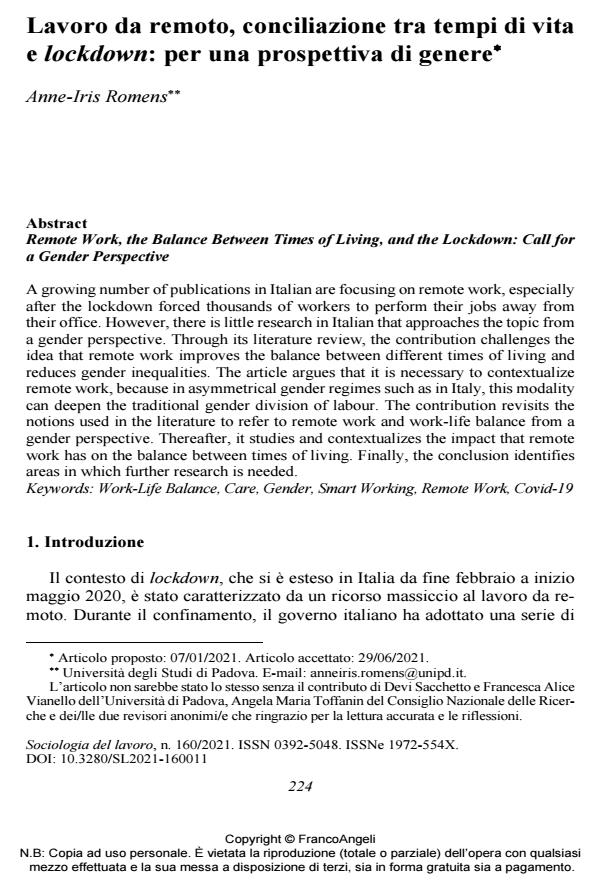Remote Work, the Balance Between Times of Living, and the Lockdown: Call for a Gender Perspective
Journal title SOCIOLOGIA DEL LAVORO
Author/s Anne-Iris Romens
Publishing Year 2021 Issue 2021/160
Language Italian Pages 20 P. 224-243 File size 244 KB
DOI 10.3280/SL2021-160011
DOI is like a bar code for intellectual property: to have more infomation
click here
Below, you can see the article first page
If you want to buy this article in PDF format, you can do it, following the instructions to buy download credits

FrancoAngeli is member of Publishers International Linking Association, Inc (PILA), a not-for-profit association which run the CrossRef service enabling links to and from online scholarly content.
A growing number of publications in Italian are focusing on remote work, especial-ly after the lockdown forced thousands of workers to perform their jobs away from their office. However, there is little research in Italian that approaches the topic from a gender perspective. Through its literature review, the contribution challenges the idea that remote work improves the balance between different times of living and reduces gender inequalities. The article argues that it is neces-sary to contextualize remote work, because in asymmetrical gender regimes such as in Italy, this modality can deepen the traditional gender division of labour. The contribution revisits the notions used in the literature to refer to remote work and work-life balance from a gender perspective. Thereafter, it studies and contextual-izes the impact that remote work has on the balance between times of living. Final-ly, the conclusion identifies areas in which further research is needed.
Keywords: Work-Life Balance, Care, Gender, Smart Working, Remote Work, Covid-19
- Ambiente, lavoro e donne per una sostenibilità al femminile nelle istituzioni scolastiche Angelo Falzarano, Raffaele Sibilio, in WELFARE E ERGONOMIA 1/2022 pp.63
DOI: 10.3280/WE2022-001006 - Diversity and Inclusion in Italy Anna Carreri, pp.685 (ISBN:978-3-031-81937-7)
- Rethinking Work-Family Balance in Italy: Case Studies and Innovative Strategies Isabella Crespi, Melanie Sara Palermo, in Corvinus Journal of Sociology and Social Policy /2024 pp.103
DOI: 10.14267/CJSSP.2024.1.5 - La rivoluzione del lavoro da remoto nel settore pubblico: quali prospettive? Francesca Della Ratta-Rinaldi, Francesco Gentilini, Sara Caria, Francesca Mattioli, Matteo Rinaldini, in SOCIOLOGIA DEL LAVORO 172/2025 pp.139
DOI: 10.3280/SL2025-172007 - The variable geometry of bargaining: implementing unions' strategies on remote work in Italy Anne-Iris Romens, Valeria Piro, Francesco E. Iannuzzi, in STUDI ORGANIZZATIVI 1/2022 pp.129
DOI: 10.3280/SO2022-001006
Anne-Iris Romens, Lavoro da remoto, conciliazione tra tempi di vita e lockdown: per una prospettiva di genere in "SOCIOLOGIA DEL LAVORO " 160/2021, pp 224-243, DOI: 10.3280/SL2021-160011